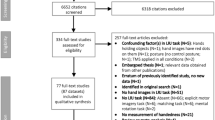Abstract
How do we decide which object to pick up when faced with two alternatives? Imagine one object is near, but needs to be carried a long distance, and the other object is far, but needs to be carried a short distance. You might predict that participants would favour the far object that needs to be carried a short distance. In other words, they would procrastinate and delay picking up an object to minimise physical effort. In actuality, participants prefer to carry the near object a long distance, which is called pre-crastination. Pre-crastination may be preferred to procrastination because picking up the first object hastens completion of the first goal of the task and, subsequently, decreases cognitive load. The goal of the current study was to further investigate the mechanisms of the pre-crastination effect. This was done by converting the primarily walking task used in the first study on pre-crastination to a reach-to-grasp task. This change enabled the measurement of the duration of information processing (i.e., reaction time) when participants decided which object to move. Surprisingly, participants exhibited a range of behaviours: about 40% pre-crastinated, 40% procrastinated, and 20% neither pre-crastinated nor procrastinated. We suggest that scaling the task down from a walking task to a reach-to-grasp task altered the physical effort, cognitive load, and the interaction between these task demands. This enabled some participants to pre-crastinate and others to procrastinate. There was an intriguing relationship between the duration of information processing and the behaviour of participants: participants with the shortest reaction time had the strongest tendency to pre-crastinate, and participants with the longest reaction time had the strongest tendency to procrastinate. These findings fit with the automatic pre-crastination response hypothesis; that the “decision” to pre-crastinate is automatic. This automaticity caused the short durations of information processing for participants who pre-crastinated. Participants who procrastinated had to, first, inhibit the automatic response to pre-crastinate, which caused long durations of information processing.






Similar content being viewed by others
Notes
The reaction time results were comparable when the absolute tangential velocity threshold was replaced with a relative tangential velocity threshold of 5% of the initial reach to the selected block.
References
Brown SG, Roy EA, Rohr LE, Bryden PJ (2006) Using hand performance measures to predict handedness. Laterality 11(1):1–14
Carey DP, Hargreaves EL, Goodale MA (1996) Reaching to ipsilateral or contralateral targets: within-hemisphere visuomotor processing cannot explain hemispatial differences in motor control. Exp Brain Res 112(3):496–504
Craighero L, Fadiga L, Umiltà CA, Rizzolatti G (1996) Evidence for visuomotor priming effect. Neuroreport 8(1):347–349
Fournier LR, Stubblefield AM, Dyre BP, Rosenbaum DA (2018) Starting or finishing sooner? Sequence preference in object transfer tasks. Psychol Res. https://doi.org/10.1007/s00426-018-1022-7
Klapp ST (1995) Motor response programming during simple and choice reaction time: the role of practice. J Exp Psychol Hum Percept Perform 21(5):1015–1027
Klapp ST (2003) Reaction time analysis of two types of motor preparation for speech articulation: action as a sequence of chunks. J Mot Behav 35(2):135–150
Langner R, Steinborn MB, Chatterjee A, Sturm W, Willmes K (2010) Mental fatigue and temporal preparation in simple reaction-time performance. Acta Psychol 133(1):64–72
Matthews G, Campbell SE, Falconer S, Joyner LA, Huggins J, Gilliland K, Grier R, Warm JS (2002) Fundamental dimensions of subjective state in performance settings: task engagement, distress, and worry. Emotion 2(4):315–340
Mon-Williams M, Tresilian JR, Coppard VL, Carson RG (2001) The effect of obstacle position on reach-to-grasp movements. Exp Brain Res 137(3–4):497–501
Oldfield RC (1971) The assessment and analysis of handedness: the Edinburgh inventory. Neuropsychologia 9(1):97–113
Potts CA, Callahan-Flintoft C, Rosenbaum DA (2018) How do reaching and walking costs affect movement path selection? Exp Brain Res 236:2727–2737
Richter M (2015) Commentary: Pre-crastination: hastening subgoal completion at the expense of extra physical effort. Front Psychol 6:1269
Rosenbaum DA, Gong L, Potts CA (2014) Pre-crastination: hastening subgoal completion at the expense of extra physical effort. Psychol Sci 25(7):1487–1496
Stone KD, Bryant DC, Gonzalez CLR (2013) Hand use for grasping in a bimanual task: evidence for different roles? Exp Brain Res 224(3):455–467
Tresilian JR (1998) Attention in action or obstruction of movement? A kinematic analysis of avoidance behavior in prehension. Exp Brain Res 120(3):352–368
Tucker M, Ellis R (1998) On the relations between seen objects and components of potential actions. J Exp Psychol Hum Percept Perform 24(3):830
Voudouris D, Smeets JBJ, Brenner E (2012) Do obstacles affect the selection of grasping points? Hum Mov Sci 31(5):1090–1102
Wasserman EA, Brzykcy SJ (2015) Pre-crastination in the pigeon. Psychon Bull Rev 22(4):1130–1134
Zentall TR, Case JP, Andrews DM (2018) Procrastination in the pigeon: can conditioned reinforcement increase the likelihood of human procrastination? Psychon Bull Rev 25(5):1952–1957
Acknowledgements
We thank Michael E McCarty for our discussion on the pre-crastination effect and Zack G Foster for assisting with data collection. We are also thankful for Michael B Steinborn and two anonymous reviewers for their insightful critiques.
Author information
Authors and Affiliations
Corresponding author
Ethics declarations
Conflict of interest
The authors declare that they have no conflict of interest.
Ethical approval
All procedures performed in studies involving human participants were in accordance with the ethical standards of the institutional and/or national research committee and with the 1964 Helsinki declaration and its later amendments or comparable ethical standards.
Informed consent
Informed consent was obtained from all individual participants included in the study.
Additional information
Publisher’s Note
Springer Nature remains neutral with regard to jurisdictional claims in published maps and institutional affiliations.
Rights and permissions
About this article
Cite this article
Blinch, J., DeWinne, C.R. Pre-crastination and procrastination effects occur in a reach-to-grasp task. Exp Brain Res 237, 1129–1139 (2019). https://doi.org/10.1007/s00221-019-05493-3
Received:
Accepted:
Published:
Issue Date:
DOI: https://doi.org/10.1007/s00221-019-05493-3




